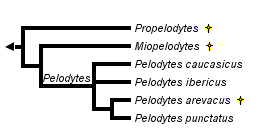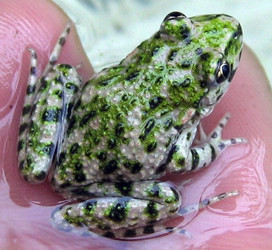Pelodytidae
Parsley Frogs
David Cannatella


This tree diagram shows the relationships between several groups of organisms.
The root of the current tree connects the organisms featured in this tree to their containing group and the rest of the Tree of Life. The basal branching point in the tree represents the ancestor of the other groups in the tree. This ancestor diversified over time into several descendent subgroups, which are represented as internal nodes and terminal taxa to the right.

You can click on the root to travel down the Tree of Life all the way to the root of all Life, and you can click on the names of descendent subgroups to travel up the Tree of Life all the way to individual species.
For more information on ToL tree formatting, please see Interpreting the Tree or Classification. To learn more about phylogenetic trees, please visit our Phylogenetic Biology pages.
close boxIntroduction
Pelodytidae are the "Parsley Frogs." The name comes from Pelodytes punctatus, a species whose green coloration makes the frog look like it is garnished with parsley. There is one living genus, Pelodytes, with two species, in western Europe and the Caucasus mountains. Fossil taxa are also known, from the Eocene to Pleistocene.
Pelodytes punctatus of Europe is a small (4 cm), gracile and agile frog with prominent eyes. It is mostly nocturnal and terrestrial, but breeds in water, with males apparently calling from under water. The tadpoles have beaks, denticles, and a sinistral spiracle (Orton Type 4).
The group is recognized as a family mainly because of the fused astragalus and calcaneum, an unusual feature in frogs (also known in centrolenid frogs). Another distinctive feature is the presence of a parahyoid bone in the hyoid apparatus. Among frogs in the Pipanura this character is known only in rhinophrynids and palaeobatrachids.
Discussion of Phylogenetic Relationships
The genus Pelodytes was considered a family distinct from Pelobatidae (sensu lato) because it has a fused astragalus and calcaneum, a derived feature seen elsewhere only in Centrolenidae (Lynch, 1973). Sanchíz (1978) reviewed the fossil forms of Pelodytidae. †Miopelodytes and the extinct Pelodytes †arevacus have a fused astragalus and calcaneum, but †Propelodytes does not. Sanchíz (1978) tentatively retained †Propelodytes in Pelodytidae.
Pelodytes was defined by Ford and Cannatella (1993) to be the most recent ancestor of the living species P. punctatus and P. caucasicus, and all of its descendants. Sanchíz (1978) considered Pelodytes †arevacus to be more closely related to P. punctatus than to P. caucasicus, and as such it is part of Pelodytes. As normally used, Pelodytidae includes the fossil forms, so Pelodytidae was defined as a stem-based name, for those taxa that are more closely related to the living Pelodytes than to either Pelobatidae or Megophryidae. The synapomorphy of Pelodytidae is the fusion of the astragalus and calcaneum. The status of †Propelodytes as a pelodytid is tenuous.
References
Ford, L. S., and D. C. Cannatella. 1993. The major clades of frogs. Herp. Monogr. 7:94-117.
Lynch, J. D. 1973. The transition from archaic to advanced frogs. Pp. In J. L. Vial (Ed.), Evolutionary Biology of the Anurans: Contemporary Research on Major Problems. University of Missouri Press, Columbia.
Sanchiz, F. B. 1978. Nuevos restos fósiles de la familia Pelodytidae (Amphibia, Anura). Estudios Geol. 34:9-27.
Title Illustrations

| Scientific Name | Pelodytes punctatus |
|---|---|
| Location | north of France |
| Acknowledgements | Permission is granted to copy, distribute and/or modify this document under the terms of the GNU Free Documentation License, Version 1.2 or any later version published by the Free Software Foundation; with no Invariant Sections, no Front-Cover Texts, and no Back-Cover Texts. A copy of the license is included in the section entitled "GNU Free Documentation License". |
| Specimen Condition | Live Specimen |
| Source | Image:Pelodytes_punctatus_with_scale.jpg |
| Source Collection | Wikimedia Commons |
| Copyright | © 2005 Teuteul |
About This Page
If you are interested in authoring or co-authoring the page for this taxon, or some part of it (even a species), contact David Cannatella.
David Cannatella

University of Texas, Austin, Texas, USA
Correspondence regarding this page should be directed to David Cannatella at
Page copyright © 1995 David Cannatella
 Page: Tree of Life
Pelodytidae. Parsley Frogs.
Authored by
David Cannatella.
The TEXT of this page is licensed under the
Creative Commons Attribution License - Version 3.0. Note that images and other media
featured on this page are each governed by their own license, and they may or may not be available
for reuse. Click on an image or a media link to access the media data window, which provides the
relevant licensing information. For the general terms and conditions of ToL material reuse and
redistribution, please see the Tree of Life Copyright
Policies.
Page: Tree of Life
Pelodytidae. Parsley Frogs.
Authored by
David Cannatella.
The TEXT of this page is licensed under the
Creative Commons Attribution License - Version 3.0. Note that images and other media
featured on this page are each governed by their own license, and they may or may not be available
for reuse. Click on an image or a media link to access the media data window, which provides the
relevant licensing information. For the general terms and conditions of ToL material reuse and
redistribution, please see the Tree of Life Copyright
Policies.
Citing this page:
Cannatella, David. 1995. Pelodytidae. Parsley Frogs. Version 01 January 1995 (under construction). http://tolweb.org/Pelodytidae/16980/1995.01.01 in The Tree of Life Web Project, http://tolweb.org/








 Go to quick links
Go to quick search
Go to navigation for this section of the ToL site
Go to detailed links for the ToL site
Go to quick links
Go to quick search
Go to navigation for this section of the ToL site
Go to detailed links for the ToL site